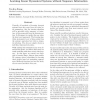Free Online Productivity Tools
i2Speak
i2Symbol
i2OCR
iTex2Img
iWeb2Print
iWeb2Shot
i2Type
iPdf2Split
iPdf2Merge
i2Bopomofo
i2Arabic
i2Style
i2Image
i2PDF
iLatex2Rtf
Sci2ools
109
click to vote
ICML
2009
IEEE
2009
IEEE
Learning linear dynamical systems without sequence information
Virtually all methods of learning dynamic systems from data start from the same basic assumption: that the learning algorithm will be provided with a sequence, or trajectory, of data generated from the dynamic system. In this paper we consider the case where the data is not sequenced. The learning algorithm is presented a set of data points from the system’s operation but with no temporal ordering. The data are simply drawn as individual disconnected points. While making this assumption may seem absurd at first glance, we observe that many scientific modeling tasks have exactly this property. In this paper we restrict our attention to learning linear, discrete time models. We propose several algorithms for learning these models based on optimizing approximate likelihood functions and test the methods on several synthetic data sets.
Related Content
| Added | 19 May 2010 |
| Updated | 19 May 2010 |
| Type | Conference |
| Year | 2009 |
| Where | ICML |
| Authors | Tzu-Kuo Huang, Jeff Schneider |
Comments (0)

